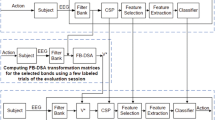Abstract
Brain–computer interface (BCI) allows the use of brain activities for people to directly communicate with the external world or to control external devices without participation of any peripheral nerves and muscles. Motor imagery is one of the most popular modes in the research field of brain–computer interface. Although motor imagery BCI has some advantages compared with other modes of BCI, such as asynchronization, it is necessary to require training sessions before using it. The performance of trained BCI system depends on the quality of training samples or the subject engagement. In order to improve training effect and decrease training time, we proposed a new paradigm where subjects participated in training more actively than in the traditional paradigm. In the traditional paradigm, a cue (to indicate what kind of motor imagery should be imagined during the current trial) is given to the subject at the beginning of a trial or during a trial, and this cue is also used as a label for this trial. It is usually assumed that labels for trials are accurate in the traditional paradigm, although subjects may not have performed the required or correct kind of motor imagery, and trials may thus be mislabeled. And then those mislabeled trials give rise to interference during model training. In our proposed paradigm, the subject is required to reconfirm the label and can correct the label when necessary. This active training paradigm may generate better training samples with fewer inconsistent labels because it overcomes mistakes when subject’s motor imagination does not match the given cues. The experiments confirm that our proposed paradigm achieves better performance; the improvement is significant according to statistical analysis.





Similar content being viewed by others
References
Anthony CS, Zoltan JK (1995) Principal-component localization of the source of the background EEG. IEEE Trans Biomed Eng 42:59–67
Carlo AP, Maria PF, Valentina C, Mathew ED, Patrizia B, Chiava Z, Massimo B, Pietro EP (1996) Primary motor and sensory cortex activation during motor performance and motor imagery: a functional magnetic resonance imaging study. J Neurosci 16:7688–7698
Dunsky A, Dickstein R, Marcovitz E, Levy S, Deutsch J (2008) Home-based motor imagery training for gait rehabilitation of people with chronic poststroke hemiparesis. Arch Phys Med Rehabil 89:1580–1588
Fabiani GE, McFarland DJ, Wolpaw JR, Pfurtscheller G (2004) Conversion of EEG activity into cursor movement by a brain-computer interface (BCI). IEEE Trans Neural Syst Rehabil Eng 12:331–338
Hearst MA, Dumais ST, Osman E, Platt J, Scholkopf B (1998) Support vector machines. IEEE Intell Syst 13:18–28
Ietswaart M, Johnston M, Dijkerman HC, Joice S, Scott CL, MacWalter RS, Hamilton SJ (2011) Mental practice with motor imagery in stroke recovery: randomized controlled trial of efficacy. Brain. doi:10.1093/brain/awr077
Jeannerod M (1994) The representing brain: neural correlates of motor intention and imagery. Behav Brain Sci 17:187–202
Li J, Zhang L (2010) Bilateral adaptation and neurofeedback for brain computer interface system. J Neurosci Methods 193:373–379
McFarland DJ, Miner LA, Vaughan TM, Wolpaw JR (2000) Mu and beta rhythm topographies during motor imagery and actual movements. Brain Topogr 12:177–186
McFarland DJ, Krusienski DJ, Sarnacki WA, Wolpaw JR (2008) Emulation of computer mouse control with a noninvasive brain-computer interface. J Neural Eng 5:101–110
McFarland DJ, Sarnacki WA, Wolpaw JR (2010) Electroencephalographic (EEG) control of three-dimensional movement. J Neural Eng 7(3):036007
Nijholt A, Bos DP, Reuderink B (2009) Turning shortcomings into challenges: brain-computer interfaces for games. Entertain Comput 1:85–94
Page SJ, Levine P, Sisto S, Johnston MV (2001) A randomized efficacy and feasibility study of imagery in acute stroke. Clin Rehabil 15:233–240
Page SJ, Levine P, Leonard AC (2005) Effects of mental practice on affected limb use and function in chronic stroke. Arch Phys Med Rehabil 86:399–402
Pfurtscheller G, Berghold A (1989) Patterns of cortical activation during planning of voluntary movement. Electroencephalogr Clin Neurophysiol 72:250–258
Pfurtscheller G, Neuper C (1997) Motor imagery activates primary sensorimotor area in humans. Neurosci Lett 239:65–68
Pfurtscheller G, Brunner C, Schlogl A, Lopes FH (2006) Mu rhythm (de)synchronization and EEG single-trial classification of different motor imagery tasks. NeuroImage 31:153–159
Ramoser H, Muller GJ, Pfurtscheller G (2000) Optimal spatial filtering of single trial EEG during imagined hand movement. IEEE Trans Rehabil Eng 8:441–446
Royer AS, He B (2009) Goal selection versus process control in a brain-computer interface based on sensorimotor rhythms. J Neural Eng 6 doi:10.1088/1741-2560/6/1/016005
Royer AS, Doud AJ, Rose ML, He B (2010) EEG control of a virtual helicopter in 3-dimensional space using intelligent control strategies. IEEE Trans Neural Syst Rehabil Eng 18:581–589
Vapnik V (1995) The nature of statistical learning theory. Springer, New York
Zhao Q, Zhang L, Cichocki A (2009) EEG-based asynchronous BCI control of a car in 3D virtual reality environment. Chin Sci Bull 54:78–87
Acknowledgments
The work was supported by the National Natural Science Foundation of China (Grant No. 90920014, 91120305).
Author information
Authors and Affiliations
Corresponding author
Rights and permissions
About this article
Cite this article
Li, J., Zhang, L. Active training paradigm for motor imagery BCI. Exp Brain Res 219, 245–254 (2012). https://doi.org/10.1007/s00221-012-3084-x
Received:
Accepted:
Published:
Issue Date:
DOI: https://doi.org/10.1007/s00221-012-3084-x




